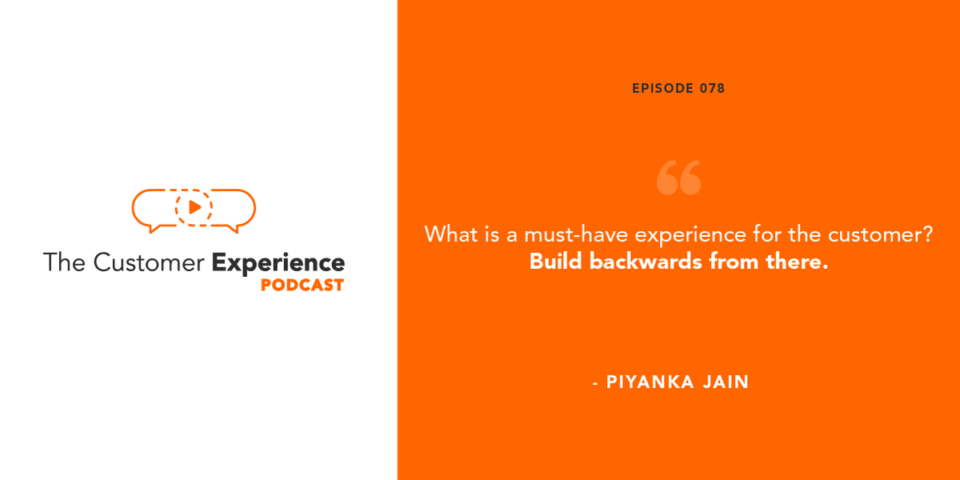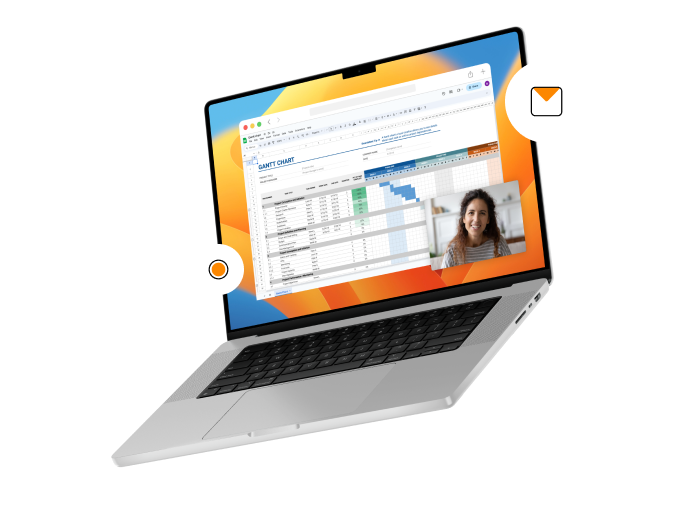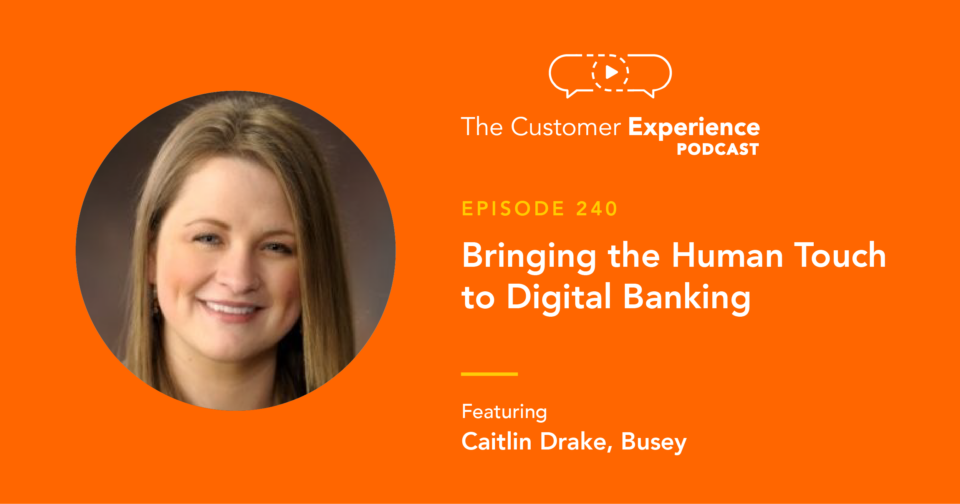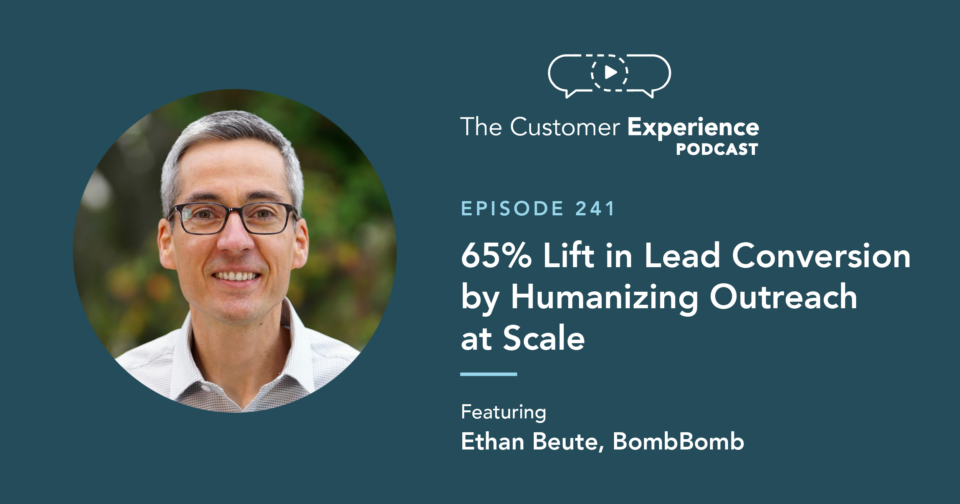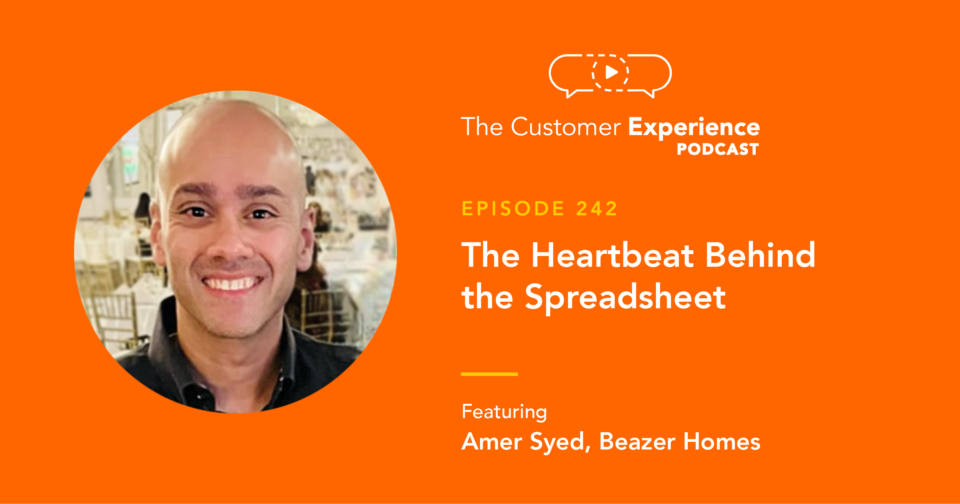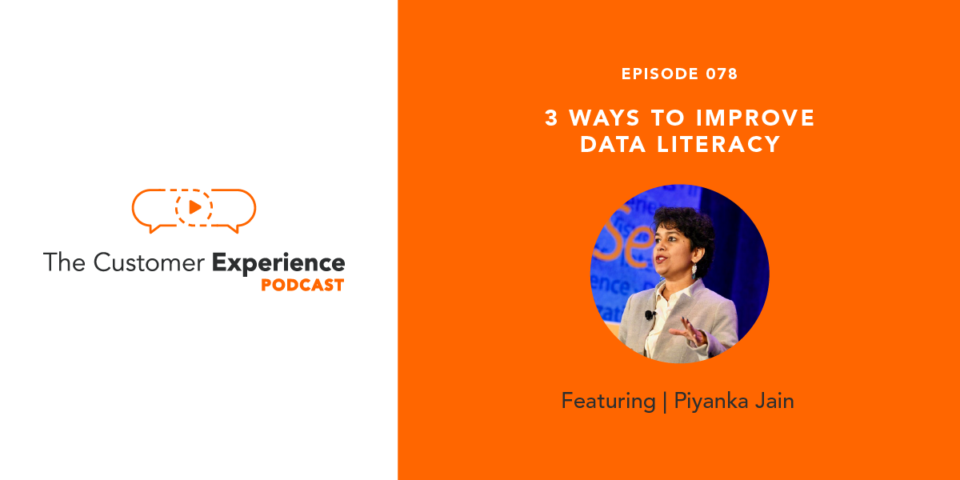
Listen to “78. 3 Ways To Improve Data Literacy w/ Piyanka Jain” on Spreaker.
Apple Podcasts | Google Podcasts | Stitcher | Spotify
Data is essential for all aspects of your business, but are you putting it to best use? Are you collecting, anaylyzing, and using your data in ways that benefit your customers and improve their experience?
To know that, we must first understand and prioritize data literacy.
Data literacy means knowing how to read and understand data, so we can use it to make decisions, like giving your customers what they want the most.
Right now, at a time of great change, it is the perfect opportunity to invest in growing a data culture so that in the post-pandemic world, you’ll collectively have the data skills to thrive.
In our first all-data discussion on The Customer Experience Podcast, we discuss not only the essential components of data culture – but also the right and wrong ways to implement data literacy programs.
Today’s guest is Piyanka Jain, President and CEO of Aryng, a data analytics company with clients like Google, Apple, Adobe, PayPal, Box, and Electronic Arts.
Her mission to spread data literacy and create citizen analysts is more urgent than ever – given the never-ending need for data-driven decision-making, data analytics, and data science.
Throughout our conversation, we talked about…
• Why developing a data strategy is essential to delivering a great customer experience
• What role personas play in data literacy
• Why uniform training on data literacy is vital
• How to bring data literacy knowledge to the “context of your workflow”
• Why executive buy-in is necessary for data literacy to take root
3 Ways To Improve Data Literacy
Hear the entire conversation with Piyanka Jain on data literacy right here:
Listen to “78. 3 Ways To Improve Data Literacy w/ Piyanka Jain” on Spreaker.
Hear this epsiode and any other by subscribing to The Customer Experience Podcast in:
Please take a minute to rate and review the show while you’re there. It’s an easy and helpful way to support us!
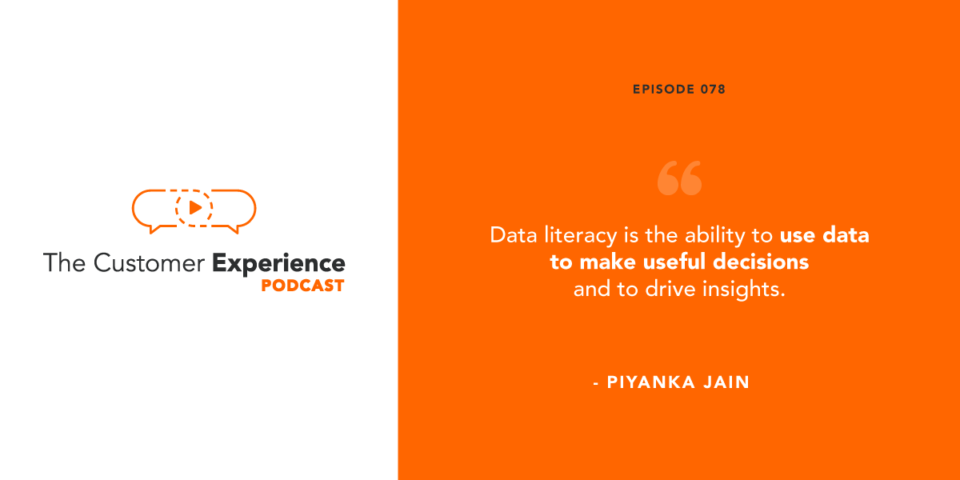
Full Transcript: 3 Ways To Improve Data Literacy
Ethan Beute:
Leveraging your data in order to lower your customer acquisition costs and improve your customer experience. Today’s guest is President and CEO of Aryng, a company that does just that for clients like Google, Apple, Adobe, PayPal, Box, and Electronic Arts among many others. A few processes and techniques for teen uses, developing their client’s DNA, building data literacy throughout the organization, and creating citizen analysts. She’s a best selling author and keynote speaker on data-driven decision making, data analytics, and data science. Piyanka Jain, welcome to The Customer Experience podcast.
Piyanka Jain:
Thank you for having me, Ethan.
Ethan Beute:
I’m really excited to get into this, and to my memory, we haven’t done a full and proper conversation on data here on the show, but it obviously underpins any effort that anyone’s undertaking throughout the organization. But before we get going, we’re recording early to mid-April, you’re in Silicon Valley. What’s the situation there with regard to the coronavirus? How is it affecting you or your family, your team, or your customers? Just set the scene really quickly.
Piyanka Jain:
Yeah, so we have been in shelter, shelter in place for a good four weeks now I think. And there going to go till May, first week of May as of now. We’ll see how it changes. The numbers are somewhat flattering. It all depends on how you see it, but testing at least is flattering. Who knows?
Piyanka Jain:
We are a remote team to begin with. I’m based here. So, there are some folks in East Bay, L.A., some folks in Toronto. We have folks in India. So, we are all remote, to begin with. So, we are set up that way, so it didn’t affect us that, from the working perspective, but our clients are definitely. We can see there’s a lot of panic and our budgets freezing and a lot of not knowing what to do. But there’s also I think a greater… There are two things we do for our corporate clients and consulting side that we do end to end. There’s also the training part we do, the data literacy data culture work, I think which is what we talk a whole lot about. And then, because this is a prime time, many people are seeing this as a downtime for their employees. There’s a bigger interest in data culture, developing data culture, upgrading skills, and so on.
Piyanka Jain:
So, there’s some shift happening within our portfolio of offering as well. But overall, we all need to do the right thing and stay safe and this too shall pass just like anything else. But yeah, I think in general people are taking it well from what I understand.
Ethan Beute:
Very good, yeah. I think it is… this too shall pass. We’re not sure exactly we are in it right now, and I think that’s why there’s a lot of freezing and not a lot of dramatic decision making, but just pause, let’s see what’s going on here and move forward. I’m really glad to hear that people are investing in training and development. That’s awesome. So, we’re going to start where we always start here, which is customer experience. When I say that, what does it mean to you?
Piyanka Jain:
For me, customer experience is a holistic experience, right? So, for example, if I am buying something online, I’m a big Amazon shopper, because I’m a big convenience lover. And so, for me that experience of how I order, how I can count on receiving when they are saying it’s receiving. So, I have six year old, and I have just ordered a butterfly project for her, because we are staying at home and I need to do something more creative and interesting with her, and so we’re going to see butterflies grow for the next three weeks. And so, I ordered something from… a butterfly kit from Amazon. I know the day-to-day comment. I know I can prep my daughter like, “You know it’s coming here, and then we’re going to be making logs and how are we going to track.” And she knows all the stages of the butterfly cocooning, chrysalis and all of that.
Piyanka Jain:
So, I love the dependability. I love the ease. Things get dropped to me. I love the ease of if something is not working, I can call in and I can get a customer support experience very, very convenient, very easy. They know me and they also probably know me as a high-value customer, so I get very easy access. Everything is easy. And I like easy.
Piyanka Jain:
So for me, customer experience is how I get attached by a product company end to end. So, not only from my ordering to my receiving the product, to my if I have a problem, the order has not arrived, what happened. It’ll be shipped right away for you. There’s something got misplaced. Whatever else. It’s not so easy, whereas having to argue.
Piyanka Jain:
So, once I started shopping in Amazon, on Amazon would be seven years ago, I haven’t gone back and I hardly shop. These days I don’t shop anyways, but I hardly shop in retail stores. Actually my daughter doesn’t know what a mall is, because we’ve never probably gone to a mall. So-
Ethan Beute:
My goodness.
Piyanka Jain:
Yeah.
Ethan Beute:
That frictionless experience. Amazon has come up a number of times on the show, especially with the closing question of a company that you really appreciate and it’s that frictionless aspect to it. And you also spoke to the transparency. You just know what’s going on and should anything be disjointed at any point, you already have this trust built up. There’s a relationship piece to that you talked about too. It’s not just about that transaction. It’s about all of the transactions for years to come. So, if you’re seven or eight years in now, you’ll obviously still be working with them seven or eight years from now. And they’ll know you better. They’ll be able to serve you better, which is awesome, which I think leads into where I wanted to go next. Just one step deeper into CX here, which is from your point of view, what’s the relationship between effective use of data and delivering effectively a high quality customer experience?
Piyanka Jain:
That’s a great question, Ethan. And I love the way you framed about trust and relationship as well. So, that’s giving some good ideas to start thinking about the way I think about customer experience. And now putting in the context of data-driven customer experience, so I think that having an effective data strategy or having an effective way of getting access to the… that we call it data maturity in general. That’s a foundation to deliver a good customer experience or build better products or delight your customer any way you want. So, that’s a foundation. That’s a must-have for you to be able to delight your customer, for Amazon to know that I’m high value, for Amazon to know that this and this person, probably they’re convenience lovers. So, don’t argue with her about things. Make it easy for her as she calls. Things like that.
Piyanka Jain:
So, you need data done well. You need good access to data and good and right access to data, to the right people, because all this decision is not being all made by… There’s a lot of AutoML going on, a lot of machine learning, and a lot of recommendation system, but there’s also people there. And different people need access, so customer support needs a different access by MyData versus the person who is doing, maybe there’s a fraud activity or something happened. Different job and persona you can call it. Different job title function need different kind of access to my customer data.
Piyanka Jain:
So, that rightful access and true access and easy access is data maturity. That’s the foundation. That is what is data maturity. When you have that, now you’re set up to actually crack the code for anything, be it CX, be it product experience, be it product features, be it marketing, whatever you want to optimize. As it relates directly to customer experience, I think the way we approach it at least for our clients, is we start thinking from what is it that you want? What is the must-have experience that you want the customer the have and then build backward from there?
Piyanka Jain:
So, once you know what do you envision, I think for example, and I look up Steve Jobs, for example, the greatest visionary, he used to talk about the experience, the experience that he wants people to have. When they hold a phone, an iPhone in their hand, this is how they should feel. This is that the feeling. If you can start from that and then work backwards to it, if we want to deliver that, what all do we need to enable on our systems and from our peoples, from our processes perspective? And from there, data can support you, in supporting that vision that you have. But that assuming you have good data maturity underlying it. Otherwise, you will be running after data and not knowing how do you chase after data, which is not existent or it’s hiding somewhere.
Ethan Beute:
It’s so good. There are so many follow up questions I wanted to ask there, I couldn’t. I should actually have been writing down some of my thoughts there. So to follow up, but a couple of key things there. One, obviously data is a means to an end, not an end in and of itself. It’s a tool to get a job done and you really positioned it clearly and obviously there, and that it is foundational to making any aspect of the business better and more effective. And you also pretty well teed up right what I wanted to ask next, which is for folks who aren’t familiar with Aryng, who are you, who is your ideal customer and what are some of the problems that you solve for them?
Piyanka Jain:
Sure, great. I would love to share Aryng. We are a science consulting company. We are boutique, so we are not large, but we are lean and mean. And our flavor of data science we do is all about practical data science. So, we are all about you have some data, whatever form of data you have. You have some questions. How do we quickly use the data you have at hand to solve that problem? Now we do that to two says for the corporate client. One is, we go in and solve high-value problems for our clients hands-on. And we are known to be the fastest and the most efficient. So, between two to three consultants can build a machine learning model within eight to nine weeks. And we are fast because we are hypothesis-driven. So, on the line, all of the work that we do is a framework called BADIR, which is our recipe for baking cake. We have a recipe for baking data essentially.
Piyanka Jain:
And it marries data science with decision science and it is hypothesis-driven, which basically enables us fast delivery to insights and makes sure whatever we will deliver for our client will get used. So, that’s our footprint so to say, our blueprint of what we do.
Piyanka Jain:
So, there’s one part, is data science consulting when we go into organizations and solve… We have customer acquisition issues. We want to lower customer acquisition cost. We want to segment our customer. We want to better target. We want to create offering and messaging, a matrix to optimize ROI. You have customer retention, employee retention, you name it, marketing to sales, attribution, all of those things. We love solving complex problems. So, that’s one end.
Piyanka Jain:
But we’re also a lot about evangelizing. So, we are all about how can we empower our customers to do it better and do it themselves? And so, there’s one big part of work we do is on data culture and data literacy. So, we go into organizations who are ready, especially very mature organizations, organization where the digital transformation has happened to them, but the employees are not ready for data. They are scared of data. And go into such an organization and we establish a culture of data to our curative framework.
Piyanka Jain:
So, we first assess the data culture for that organization. Again, we have a methodology for that. And then, based on what we find, the gaps in either data maturity. We talked about data maturity already, or data literacy. That’s the second. There are four Ds to data culture. The second one is data literacy. The third one is their driven leadership, and the fourth one is decision-making process.
Piyanka Jain:
And as we find gaps in any of those four, which is broken down into many dimensions, we are able to address that and fairly quickly. We can do a turnaround from moving a data culture portion of five to about seven within nine months if the organization is ready. And a large scale. We can scale it to 5,000 – 10,000 people. So, that’s our two bodywork we do for our corporate clients.
Piyanka Jain:
We also have an academy, much like Coursera, but it’s focused on the business problems. So, we have an academy where people can go on academy.ayrng.com and they can take, especially for sales and marketing folks, there’s a citizen analyst track that they can upscale themselves with 16 hours of course and then a follow-on project. We have a future data scientist track. We also have a current scientist data track and executive track.
Ethan Beute:
Awesome. I will link that up in… For folks who are listening, we always write up these episodes, pull a hand full of video clips, we embed the audio and you can see all that at bombbomb.com/podcast and I’ll include a link to the academy for folks that… And we’re going to get into some of those definitions by the way. I’m curious to talk about citizen analyst, so people can self identify and maybe jump into one of those learning tracks as they see fit.
Ethan Beute:
So, let’s talk about some of the basics of data literacy. I expect that many organizations probably wouldn’t call themselves data illiterate, but I’ll also bet that many of them are metric rich but information poor. And so, just talk about how do you define data literacy and for the companies that you’ve engaged with or that your team is engaged with over the past couple of years, what is a common state of data literacy? And then we can maybe progress from there.
Piyanka Jain:
Yeah, that’s a great question. So, from the last research I read coming from I think Accenture and Hewitt published it together, from the global survey they did, they found less than 64% of people… Sorry, 64% or more of the people were not identified as data literate enough.
Piyanka Jain:
And then what is data literacy? So, data literacy is the ability to use data for making useful decisions, to use that for… to derive insights and useful decisions. No, that is not one size fit all. You can’t say I’m data literate or illiterate. The level that I’m functioning, if I’m a customer support agent, do I have the right data literacy for my level? And so, how do we define that? We define that at personal level. So, our customer support agent, maybe they need to be a data enthusiast. Again, that definition varies across business to business and what the leadership wants for that role.
Piyanka Jain:
So, for example, most of the time customer support agents are tend to be what the target data literacy profile they should get to as is data enthusiast. For a marketing manager, the target profile is often data educated or actually sometimes there’s an analyst. For a product, usually, it’s data educated. For executives, it’s typically data-driven executive. So, these are definitions, but they’re basically varying level of data literacy. Some people, if you start from the data enthusiast, they need to be enthusiastic about data and to be able to understand basics of charts and tables, right?
Piyanka Jain:
All the way from there to data scientist, they need to be able to use advanced methods to be able to derive insights and make models and inform decisions and work with stakeholders and … So, there’s a wide variety of those and everything is in between. Right?
Piyanka Jain:
So, when we go into the organizations, most of the time we are finding less than 10% of the people are at the appropriate level of data literacy, less than 10%, which is shocking. Most people think, oh I can download data in Excel and I can look at it and I can fix the number, so I am data literate. Well, are you data literate enough for your level of what you are able to do? And the surprising and the sad truth is most people are not. And what does that mean? Why should we care if they are data literate or not? We should care because if they are not data literate enough, they’re not able to optimize the decision they have at hand. Your marketing manager, who’s going to spend your 100K in next quarter, if they’re not data literate enough, they’re not going to be optimizing that 100K to spend. Maybe they’ll spend 100K and they’ll get you 500K in return from incremental sales or whatever else.
Piyanka Jain:
But what if they were data literate and they could get you a million? Right? You are losing, you’re leaving that 500K on the table. And many, many CEOs and CMOs and…they are recognizing oh wow, we are leaving money on the table. And especially in the context of right now in this post-pandemic situation, all of our margins have been eaten away. We have kept our employee’s level to the same level. All of us are, in sales and marketing specifically, our pipe plants have dried up. You’ve got to be squeezed on both ends. Can you afford to do, oh I’m going to do these 10 things, and let’s see which one sticks? Can you afford that anymore? You can’t.
Piyanka Jain:
In fact, I predict that companies who invest in data literacy right now, who invest in upscaling their employees, they are the ones who are going to thrive post-pandemic, because post-pandemic, there’s going to be a new word, right? And if you don’t know the language of business, if you don’t know the language of business data, you don’t know what to do with data, I think you’re going to be left behind. You’ll need to look for another profession.
Ethan Beute:
So interesting. Obviously now I understand why you used personas earlier in the conversation because that’s essentially what you’re talking about is mapping the appropriate level of literacy to the appropriate role or to a specific role rather. It is also really interesting to think about, coming into the conversation as I think about my own challenges in using data, they’re often around, should I believe this source or that source, am I getting the right data, can I trust it, is it being presented the right way, it is hygienic, et cetera. That’s a completely separate set of challenges and problems. You’re talking again with literacy in particular very specifically about do people actually understand what’s being presented? I would assume that asking the right questions probably critical to effective data literacy.
Ethan Beute:
So, you started with that 10% number. Share anything that just came to mind there and then maybe give a couple of tips on if you want to make that path from 10% to 40% literacy, what are some easy things… I shouldn’t have said it that way. What are some things that could be done to start moving that direction?
Piyanka Jain:
Yeah, that’s great. There’s lots there and I want to address everything. So, the part that you talked about, it was about, is the data accurate, and is it making sense, where I can I get it? That is all data maturity, so that’s why there are four Ds of data culture. The part that you talk about is the foundation on which everything else sets. If you don’t even have easy access to single source of truth, everything else will be irrelevant, because you can train a best data scientist. If they don’t have access to the right data, what will they train their bodies on? Right?
Piyanka Jain:
So, data maturity is the part that you talked about and a lot of people think about data when they talk data literacy. They start thinking about oh, where do I get this data from? All of that is data maturity. So, that’s the foundation. If that’s given to some level, there’s not a zero, one, for data maturity, but that’s given meaning you are on a scale of zero to 10, you’re a seven or up. That means you have some good cohesive sense. Maybe you have to click your tableau, dashboard and wait for five minutes instead of five seconds.
Piyanka Jain:
Okay, understand there are some hurdles and hiccups in your customer experience, but you can get data. That means you have some level of data maturity that can enable the rest of the three Ds. The other three D’s that we talked about is data literacy, data-driven leadership and decision-making process.
Piyanka Jain:
So, talking specifically about data literacy… So, let me talk about the do not’s and then we can get to do’s. Right?
Ethan Beute:
Super.
Piyanka Jain:
Here’s what’s happening and I share this with a little bit of frustration because I am part of these conversations where a CEO has told maybe a head of the D&A or head of VR, or CIO and saying, “We need a cultural data. Let’s upscale. Let’s get data literacy. Let’s get data literacy.”
Piyanka Jain:
So, the CIO or the had of D&A or something sets up a meeting with L&D leader, 10% say, “We need data literacy. Can you go find out what training we can put our employees through?” And then you can imagine what goes on after that. They start looking for training. Sometimes we surface up in that conversation. I’m having a conversation with the L&D leader and they’re saying, “We need this training. You guys have this training. We just need this training. We can license it.”
Piyanka Jain:
And I’m sitting out there and thinking, “We can license this training to them, but they are not going to get data literate.” You know why, Ethan?
Ethan Beute:
They have insufficient maturity?
Piyanka Jain:
Well, first of all, their approach is let’s train everybody. Data literacy is not one size fit all. Right? The customer support agent will need to be a different level than the executive. They need a different skillset.
Ethan Beute:
Yeah, the persona mapping.
Piyanka Jain:
Persona mapping. So, without even persona mapping and persona map needs to mapped to competencies. You haven’t thought about competencies and skills, you haven’t thought about personas, you want to put everybody through one training, so in three months you can just say, “Oh, data literacy, done.” It’s not going to happen. And you know who you’re going to blame? You’re going to blame the technology or the training material. None of them are to be blamed. What is to be blamed is you haven’t thought through this. What is data literacy? What is my vision for data literacy and how am I going to get people to these different levels of data literacy? Right?
Piyanka Jain:
And when you start thinking that way, you automatically will start thinking about competencies, you’re going to think about what is the output I want, what is the outcome I want, at which level? And that means you will start thinking what are the current levels? You are going to start with assessment. All those things will naturally happen when you start thinking that way.
Piyanka Jain:
The other thing which people do and we all do, right? Haven’t you and I, we’ve all gone to training, we’ve been so excited with it online or offline or off-site, sipping a glass of wine and taking notes, wow this is so fundamental, this is mind-blowing, and you come back to work and you’ve forgotten all about it. You talk about it with your coworkers for two days, three days. Next week you kind of don’t remember. The week after, you have forgotten what you learned there and your notes will sit there and you’ll probably never go back to looking at them.
Piyanka Jain:
What’s happening there is that we have not contextualized the learning in our workflow, and data literacy, data science is not a trivial skill. So, think about even a more… It’s more complex skill and then you don’t practice if you didn’t bring it to somebody’s workforce. You just send them to training and you expect them, oh our employees are data literate. It’s not going to happen. You need to bring that training in the context of your workflow. So, they need to do, one thing that we found to be successful is, they need to do a project, follow-on project where they get to apply it right away. That urgency is very important because these are complex concepts. Somebody who has never seen a histogram versus pie chart, and you’re saying which information you’re going to represent which way. How are they going to connect the dot? It’s too hard.
Piyanka Jain:
So, we have to immediately and that’s why we use a framework, well base approach. We teach using BADIR and the reason we do that is because it’s fairly complex. And so, if I want to today start, for example, Ethan, do you cook?
Ethan Beute:
I do.
Piyanka Jain:
Okay, have you ever made falafel?
Ethan Beute:
I have not.
Piyanka Jain:
Okay, so the question for you is, if I asked you tomorrow, “Can we make falafel tomorrow?”, how are you going to do it?
Ethan Beute:
I’m going to start with what are the ingredients, so I make sure I have them.
Piyanka Jain:
Exactly. So, you’re going to look up some recipe, and the middle of the recipe is going to tell you the steps and going to tell you the ingredients. And falafel, because it’s for so many of us, it’s so out there, we need a recipe. The same way for data science and getting those data science skills. We need a recipe. And that’s why we have the BADIR framework. If you have the framework, if you have a recipe and you are taught step-by-step how do to this, how to do this next step, how to do the next step, you have something to now, take it to your workforce. And now you have a framework, then we want you to apply it to a use case.
Piyanka Jain:
Okay, I’m in marketing, I have this 100K to spend, this is what I was thinking about spending. Now that I have this framework, let me see if I can do a better targeting, better segmentation. And I can do that and now I can apply it. And while I’m applying it, of course, this is the first time I’m frying falafel, I don’t even know the consistency of the balls that need to go into the frying pan. Oh, I have a mentor. I have somebody who has done this and they say, “Oh, this is too liquidy. We need to add more flour in it. Whatever else.” Okay, now somebody’s guiding me. And that’s what a data science mentor, that’s what we do. When we do large, enterprise-wide data literacy, we have mentors either from our team or the train-the-trainers we have trained, who go in and are mentors on this framework, apply it to their workflow.
Piyanka Jain:
But end of that exercise, by the time they’re done with their targeting and segmentation, that one project, it may take them four weeks, maybe it takes them six weeks. By the time they’re done with that, now the framework is there. They know how to apply this framework. Maybe they’ll not get everything from the class, but they’ll know. At least they’ll know how to take this framework and apply it at least to this use case.
Piyanka Jain:
Now you have empowered many, many of these marketing folks. Together they are working. Many of the sales folks. You are creating a surround sound. Everybody is talking hypotheses, business question. You are talking the same language. You start developing a culture, at least your data literacy is up. But wait, if it stops there and your leadership is still not data-driven, they’re still making decisions irrespective of data. They’re still not holding their team accountable. Slowly, there’ll be no point in that data literacy. Right? So, the data-driven leadership needs to come up as well.
Piyanka Jain:
And then lastly, data-driven decision-making process. If there isn’t a process by which decisions are being made, then the model’s data will be happening here and the decisions will be happening in a parallel path, and they have no connection, and you are not going to be optimizing your decisions based on data.
Piyanka Jain:
So, data-driven decision-making process also needs to come up. The planning and the review process both need to have data in a systematic manner that you can say, “Hey, we planned on this. We were expecting an ROI of 10x. We actually got 8x. What happened? What was our assumption? We had the assumptions wrong. And how can we use this information for next set of planning?” And that’s only possible when you can have this kind of process.
Piyanka Jain:
So, I know I gave a long rambling answer here, but hopefully-
Ethan Beute:
No, that was really good. I didn’t want to stop you, because you were essentially answering one of the question I had, which is this obviously needs to be cultural. It needs to be deeply baked into who we are. This is how we do it around here. Any cultural element is that way. And so, one of my questions for you was going to be, how do we make sure that this isn’t just a project that those people over there are working on? And really you addressed it and I think that’s that the four D’s framework is really all about, is again, combined with that persona mapping, doing the project work. I know that’s how I learn best is I’m going to do a little bit of studying on my own, but I’m going to pair up with someone who’s done it once before, we’ll do it together. Then I’ll maybe do it on my own and know that that person is within an arm’s reach if I need to reach out for a question. Then I’m off and running.
Ethan Beute:
And so, this idea of making sure people are doing projects relevant to their role, relevant to the new learning right away, and it’s unique from what someone on another team is doing in a different seat, makes so much sense.
Ethan Beute:
And so, there are two places I want to go. I guess I’ll start here. Where does this process go wrong? I think you already alluded to some of them, is particularly around executive buy-in, but are there any other common hurdles? If you’re getting some of these pieces in place, what has prevented people from really making full cultural adoption?
Piyanka Jain:
Yeah, and I can talk about some of the most common mistakes I’ve seen. One thing people are doing like I said, the L&D leaders, the HR leaders, sometimes the IT teams, they’re going out there and buying courses and maybe sometimes university courses, the local universities… I used to teach. I am a graduate student, so previously I was teaching statistics there and then I was teaching calculus. So, I know how statistics start for a senior-level class, for statistics and math major. I know how statistics start there. Also, in the context of business.
Piyanka Jain:
That statistics doesn’t… You take the class and you learn about averages and means and maybe some error and maybe bell-shaped normal distribution. And then you come to the world and saying, “Oh, now you apply your targeting and segmentation.” There’s such a gap between the two and I had to bridge that gap. So, I come from two Masters. Both of my thesis and role applied statistics and mathematics. I have a…I was talking about AI, robotics, and AI AutoML. At that point, 20 years ago… I’m repeating myself, but 20 years ago we were working on that, right? And then I come to the real world and nothing that I had learned, I was doing nonlinear aggression there. And then I come to this real-world and I joined Ruby and I was given this problem of how do we better engage our customer?
Piyanka Jain:
It doesn’t come together. I didn’t know what to do. I have all the skills. I have all the skills, but I don’t know how do I apply it? And slowly and I feel miserably initially. And then, over a period of time I learned this process, because I’m so in fact driven, I was dissatisfied with just being able to do simple cross tabs or something. I’m not fully utilizing the tool kit. And as a result, I double up the framework BADIR. The framework came out of this journey that I had myself of how do I take all of my background and then all of this business context? And I put in the context and gave it to people in a recipe that they can do. At some point I got really good and my team got really good and we became a SWAT team for PayPal and all of that happened.
Piyanka Jain:
And so, I just basically condensed all of that learning into this framework and thereby it makes it easy. When you start teaching BADIR in the context oh, here’s a winery, how would you optimize their marketing spend? Or here’s a hospital. How do you optimize their outcome, disease outcome and discharge outcome and all of that? When you start teaching people in that context and then you teach them, you can teach them averages and statistical errors and all of that. But when you teach it in the context, that’s when it connects and I think too many people are going the wrong way. One is they’re doing it for all this training, mandatory for all employees. That’s a waste of time. You’re going to get… What is it called? Fatigue. Employee fatigue, because too many hours spent and they don’t see the value. Not everybody needs to be that right level.
Piyanka Jain:
So, that’s the one mistake I see people doing, one training for all.
Ethan Beute:
And the cognitive and emotional energy again to cover that gap that you describe, which is like I got this uniform training, but how does that relate to me? I know that this is important because we all did it, but I don’t know what it needs. And so, all this wasted energy.
Piyanka Jain:
Out of context.
Ethan Beute:
Yeah, sorry.
Piyanka Jain:
Yes, out of context. And then teaching them Python. Does everybody need to learn Python? 20% of your problems should require actually you learning to use Python and using statistical methods of machine learning methods. Why is everybody learning Python? Why is everybody learning SQL? So, you’re investing. You’re taking too much of your employee’s time and putting them through a generic training and you’re going to create frustration and there’s going to be very little learning transfer rate, because you’re not teaching them in the context. And then whatever transfers, you’re going to lose it, because you’re not doing use case after that, right?
Piyanka Jain:
So, specifically in data literacy, these are the things that I’m going to talk about, which these are the do not do, because you’re going to fail and you’re going to come out six months later, you’re going to say… And the last thing is they don’t define success matrix. You go in for the project and you ask the Learning & Development managers and HR managers, “So, how are you going to measure the success of this project, if this works or not?” “Oh, that’s a good question.”
Piyanka Jain:
If you don’t define what is success for you, that means you don’t know six months later, nine months later, if you’re successful or not. You’ll just have some surveys that people have filled out where they have a voice or it was a waste of time or whatever else. But how would you know what worked or not? Right? So, I don’t know. There’s a lot to go here, but I’m giving some of the top things. Don’t do this. Think about your strategy first. Think about your data, data literacy goal. Think about that persona mapping and strategize it. Who needs to be at what level? Spend that transit time.
Piyanka Jain:
The other thing is, it cannot be done without executive buy-in. And we again get too many of these requests, oh we’re going to do this data literacy, but we don’t need to… And our first step is voice of executive. And they say, “Oh, voice of executive. We don’t need to talk to executives. Why do we need to waste their time?” You can’t change a culture of the organization without executives putting in their skin in the game. Right? It’s not possible. You’re talking about changing the culture and that’s shifting the mind. Who is marketing manager going to look up if the CEO and the leadership, the CMO, is still making decisions right out the back, the seat of the pants? Why are they going to be data driven? Why are they going to pick up these skills? Right?
Piyanka Jain:
So, I think that’s another big failure. I see people think, oh it’s siloed approach. Let’s just fix this team. This team is not functional. Let’s fix this team. You could fix the team all you like, but unless you fix it systemically, you’re not going to be able to drive cultural data.
Ethan Beute:
So good. Another drive into making into a cultural transition, not just a project orientation. So, you’ve talked about the data driven executive, you talked a little bit about the data enthusiast. I can imagine what the data skeptic is, but I’m really curious to hear more about the citizen analyst. What are the characteristics of a citizen analyst and what are maybe a couple roles in an organization that, that maps to?
Piyanka Jain:
Yeah, that’s a great question. So, going back to my 80 training. 80% of the problem, you and I as individual professionals, should be able to use simple analysis and do it in Excel. Excel or whatever tool of choice you have. So, Excel everybody has, but whatever tool of choice you have at hand. This means 80% of the problem in marketing, in product, in customer support, is solved by using simple aggregate analysis, correlation analysis, sizing and trend analysis. Those simple methodologies, RFM for example, for segmentation… Simple stuff can solve 80% of your problem.
Piyanka Jain:
So, citizen analyst, there are two… So, marketing managers, product managers. Typically marketing folks and the product folks. Now product folks need to do this simple analysis. So, they need these basic skills to be able to utilize Excel for example I said, in graph and chart and… The systematic again, we call this BADIR framework, but hands-on business analytics. They need hands-on business analytic skills for that.
Piyanka Jain:
For marketing folks, they need a little bit more. They need A/B testing as well to be able to do control, control experiments. If I did this versus if I change the shade of this button from pink to red, what happens? And all of those things.
Piyanka Jain:
So, there are two personas, the PC data educated and the citizen analyst that we use typically in the organization. Typically, in an organization there are six to eight personas. Sometimes there’s need for more and we introduce more personas. But typically for marketing product, a sales person, they fall somewhere between data literate, data educated and citizen analyst, depending again on the outcome. Sometimes sales people, sales professionals, they need to be able to utilize the outwork from a D&L team, but not necessarily do some things hands-on. They need to be able to understand it, because their literacy level needs to be data literate. Right?
Piyanka Jain:
But then again, these are not set and stone definitions. They vary by organization, because the organization’s goal is different. For some organization a product manager needs to be able to pull data using SQL and do real time testing and so on. Then they’ll need a higher skill for that level, right? Higher data skill. So, it varies, but this is roughly what it fits in.
Ethan Beute:
Really good. Thank you so much for that. I’m glad I asked that. Before we go to a couple of closing elements, any closing thoughts for you here? Any hopes or expectations for a better data future? If you want to impart one big message to put a button on? This is really interesting and wide ranging. I wish I wasn’t so ambitious with how much we wanted to learn or how much I wanted to learn with my time with you, but anything you want to add here?
Piyanka Jain:
My last thing I want to tell your audience is this is a perfect time to learn. Two birds, one stone situation. Right now and again, we are recording in early April, so pandemic and even post pandemic, this chaos, this news, the depressing news and all of that is going to continue. And it’s a time of transition. I mind that transitioning. When I get up every morning, I don’t know what’s happened in the world. The world is transitioning.
Piyanka Jain:
That means our mind is in the perfect place to learn. So, if you are yourself an individual wanting to invest in yourself, learn the skills. If you are a leader, invest in your team to learn, because post pandemic, it’s a situation where you can’t do without data. If you invest in your team right now, you’re going to get 100…, because each and every of your decision is going to be optimized in future. And you want that because the margins are gone for 2020 at least. Right?
Piyanka Jain:
And as an individual, I would also say, invest time in learning, because I heard from some podcast, that fires new neuron connections, and it actually makes your brain grow, and is actually towards a better wholesome you versus the news that we have been bombarded with. It’s really depressing. So, I would say right now is the perfect now. Right now I’m continuing on, 2020 is not an easy year, perfect time to learn. If you are, you’re a sales and marketing individual wanting to invest in time, invest your time in it. So, learn these skills. It’s going to be very, very useful. And also, if you are a leader, invest in data literacy. Invest in data culture for your organization. It’s going to serve you really well, so that you’re going to try as a company and serve your customers betters.
Ethan Beute:
Wonderful. For folks, again, I feel like I was overly ambitious in what I wanted to do here. If anyone wants to go back, we’re doing full transcripts, we’re doing video clips, we’re doing summaries at bombbomb.com/podcast and when you visit that page, not only can you see the most recent episodes including this one, but you might also enjoy episode 36 with Sarah Toms from the Wharton School at Penn. We talked about the financial side of CX, which customers should you invest in and using LTV and other data to figure out where to invest. And then episode 65 more recently with Chris Hicken, we talked about product usages of vanity metric and we talked about a number of metrics and how different teams within the organization can use them.
Ethan Beute:
So, before I let you go, I would love to give you the chance, because relationships are our number one core value, to think or mention someone who’s had a positive impact on your life or your career.
Piyanka Jain:
I am listening a lot these days, again, so bombarded with news and not so good. I’m listening a lot to neuroscientists, potentials, augmented reality. I’m going completely in different direction these days, because that helps see a bigger… I can zoom out of this situation and see a bigger sale. So, I’m listening a lot to Dr. Joe Dispenza these days and this whole aspect of we create our own reality, and Abraham Hicks, and I really love the empowering that comes from it. Energy makes matter. I love this concept and from Einstein we know this E = mc2, but I don’t know how it translates to my world and I’m loving this idea about energy makes matter and how I can energetically change the vibration of what I am thinking or what I am doing, and actually manifest matter.
Piyanka Jain:
So, I’m loving that and it’s having a huge and significant impact for me. And then, obviously all the good folks who came before that and who opened my mind. I’m a lifetime learner, so I love learning. And so, I’m learning from a new scientist, a neuroscientist right now.
Ethan Beute:
Awesome. And you already mentioned Amazon in the context of data and customer experience. Is there another company you maybe really appreciate or respect for the way that they deliver and experience for you as a customer?
Piyanka Jain:
Well I can probably name quite a few, but I love the new age, new startup companies, who are all about image, must have experiences for their client. And so, I’m a customer for ThirdLove. It sees one of our clients and this aspect of their, and then many, many others, but this aspect of being able to make things easy for their customers, to be able to give them choices, to empower them, and to sell them seamlessly, not overtly, but… I don’t know the opposite of a word. But basically, make it seamless, make it easy. And I’m a convenience and ease lover. And so, all these new startups and experiences like there are lots of startups about giving science kits. They’re making science kits for my child and all of those.
Piyanka Jain:
I love these companies who makes seamless experiences. That does it for me. Then it’s not a question of who much money I’m going to pay. It’s a question of oh, I got the experience. And now, also I’m looking at, these days I’m very attracted to positive news coming out, so the companies who are investing in their employees, companies that are making… I’m a big fan of Bill Gates and the kind of investment he’s doing in vaccines and how Facebook is using its platform to spread positive information about COVID, and I love these things that people with such a big network, such a big influence, are doing such high-value work for the humanity. So, I love these. I don’t know. I rambled on again, but-
Ethan Beute:
No, no, no. That’s really good. I’m never going to stop someone’s who’s talking about the positive. Piyanka, this has been awesome. If someone wants to follow up with you or they want to learn more about Aryng, where would you send people if they want to follow up on this conversation?
Piyanka Jain:
They can go to ayrng.com and from there they can reach us, reach out. And there’s a lot of resources there people can download and case studies. And we share exuberantly, so we have lots and lots of cases. We write a lot, we talk a lot. So, download stuff from there. If you do want to reach out, you can use the phone there. You can also follow me on LinkedIn or connect with me on LinkedIn and you can also follow me on Twitter. My handle is AnalyticsQueen.
Ethan Beute:
AnalyticsQueen. Perfect, I love it. This has been so good. I appreciate your time so much. I hope you enjoy the butterfly kit with your daughter and I will share all of these links at bombbomb.com/podcast.
Piyanka Jain:
Thank you so much, Ethan. It was a pleasure talking to you and I really enjoyed our conversation.
Ethan Beute:
Thank you.
Video Highlights: 3 Ways To Improve Data Literacy
Check out the top five video highlights from the discussion with Piyanka below…
1. Data Strategy and CX
2. Data Literacy by Persona
3. Data Literacy Problem 1 – Uniform Training
4. Data Literacy Problem 2 – Lacking Context for Learning
5. Data Literacy Problem 3 – No Executive Buy-In
Other Episodes You’ll Enjoy:
- “The Financial Side of CX: Which Customers Should You Invest In?” with Sarah Toms (Co-Founder and Executive Director, Wharton Interactive)
- “Product Usage as a Vanity Metric” with Chris Hicken (Co-Founder and CEO of ‘nuffsaid)
- “Using Tech to Scale the Human Touch and Build Community” with Stef Caldwell (Senior Customer Success Leader and Community Architect, Narrative Science)
Please Subscribe to and Rate The Customer Experience Podcast:
